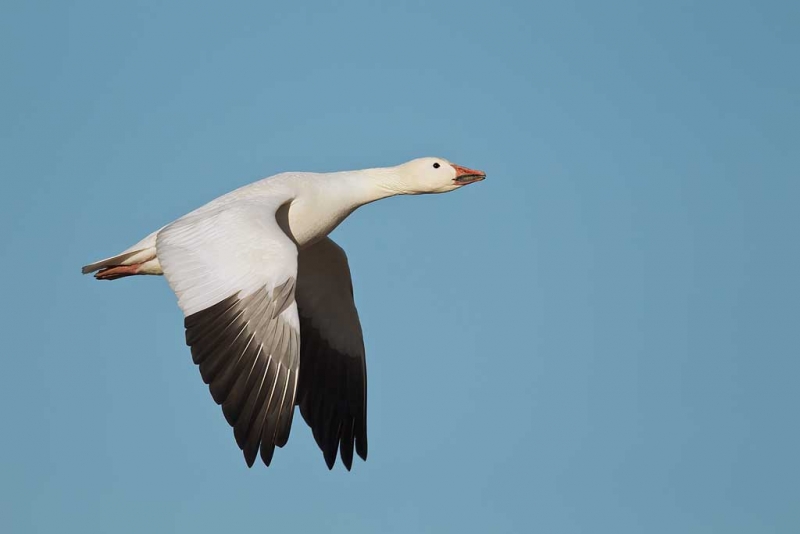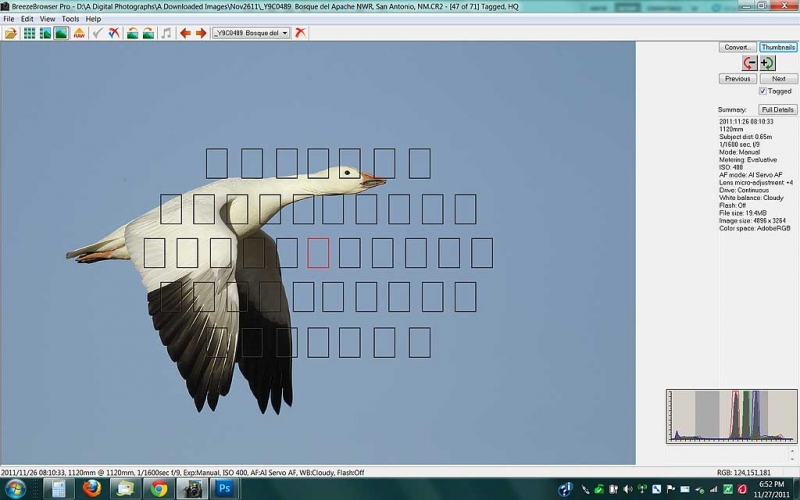|
Snow Goose in flight, Bosque del Apache NWR, San Antonio, NM. This image was created with the tripod-mounted Canon 800mm f/5.6L IS lens, the 1.4X III TC, and the EOS-1D Mark IV. ISO 400. Evaluative metering +2/3 stop off the blue sky 30 degrees above the horizon: 1/1600 sec. at f/9 set manually. Central Sensor (by necessity) Rear Focus/AI Servo AF active at the moment of exposure. Click here if you missed the Rear Focus Tutorial. Lens/TC/camera body Micro-adjustment: +4. For a greater appreciation of the image, click on the photo. Then click on the enlarged version to close it. |
Snow Goose Perfection?
As you can see by looking at the BreezeBrowser screen capture below, the image above is full frame. It was created on a very, very windy morning at 8:10 am. It was so windy that I cut the birds in half in more than a few images. Even though I expand the active AF point left and right as described in our Mark IV User’s Guide, only the central sensor is active when you add a 1.4X TC to the 800 (that only when using a pro body). In other words, despite the fact that the sensor was not anywhere near the subject at the moment of exposure, the image is critically sharp.
This wing position, the full downstroke, is my favorite; I just love the great look at the black primaries and the grey greater primary coverts and alula on the near wing. (See the great diagram here.) I love the composition right out of the box and I love the sharpness and the light and the head angle angle. And I like the tone of the blue sky.
I am not sure that I could have done any better. What do you think?
Is This a Perfect Image?
Do you think that the image above is perfect? Please let us know yes or no and why.
Earn Free Contest Entries and Support both the Bulletins and the Blog by making all your B & H purchases here.
More and more folks are earning multiple contest entries with their B & H purchases. See here for details on that. Eleven great categories, 34 winning and honored images, and prize pools valued in excess of $20,000. Click here to visit the competition home page.
Shopper’s Guide
Below is a list of the gear used to create the image in today’s blog post. Thanks a stack to all who have used the Shopper’s Guide links to purchase their gear as a thank you for all the free information that we bring you on the Blog and in the Bulletins. Before you purchase anything be sure to check out the advice in our Shopper’s Guide.
Canon 800mm f/5.L IS lens. Right now this is my all time favorite super-telephoto lens.
Canon 1.4X III Teleconverter. Designed to work best with the new Series II super-telephoto lenses.
Canon EOS-1D Mark IV professional digital camera body. My two Mark IVs are my workhorse digital camera bodies.
And from the BAA On-line Store:
LensCoats. I have a LensCoat on each of my big lenses to protect them from nicks and thus increase their re-sales value. All my big lens LensCoat stuff is in Hardwood Snow pattern.
LegCoat Tripod Leg Covers. I have four tripods active and each has a Hardwood Snow LegCoat on it to help prevent further damage to my tender shoulders 🙂
Gitzo GT3530LS Tripod. This one will last you a lifetime.
Mongoose M3.6 Tripod Head. Right now this is the best tripod head around for use with lenses that weigh less than 9 pounds. For heavier lenses, check out the Wimberley V2 head.
CR-80 Replacement Foot for Canon 800. When using the 800 on a Mongoose as I do, replacing the lens foot with this accessory lets the lens sit like a dog whether pointed up or down and prevents wind-blown spinning of your lens on breezy days by centering the lens directly over the tripod.
Double Bubble Level. You will find one in my camera’s hot shoe whenever I am not using flash.
Be sure to check out our camera body User’s Guides here.
The Lens Align Mark II. I use the Lens Align Mark II pretty much religiously to micro-adjust all of my gear an average of once a month and always before a major trip. Enjoy our free comprehensive tutorial here.
Canon EOS-1D Mark IV User’s Guide. Learn to use your Mark IV the way that I use mine. Also available for the 7D and the Mark III here.
















It’s a beautiful bird. But, yes I see the banding too, though I didn’t notice till after reading Mike Ms comment. It’s like a near invisible set of diverging halos emanating from the subject. I’ve seen it on plenty of website images all over the web, but never on any original images.
The image is very beautiful and it is perfectly sharp. But in correlation with photo judgement I would never consider the word „perfect“ …there is personal taste but no defined criterias for a perfect photo 🙂
I MUCH prefer your snow goose photo from the Bosque Mid-November Report Arthur. I’m a fan of really diffuse backgrounds but with some colour graduation or change somewhere. I also like the light in that photo. Both excellent photos and down to personal taste i feel 🙂
I agree that this is an absolutely superb photograph. Exposure , focus, timing and composition are about flawless.
But I do see a problem with the photograph, at least I do on my screen. I see a subtle concentric banding in the blue sky, especially on the upper righthand side.
If the banding is in the photo and not just on my screen, I would assume that this would be a very easy fix. Either way, great photo!
Thanks. Yes, there is a bit of banding in the jpeg that is not present in the TIFF. Not sure where it came from. artie
Excellent image. I am a little puzzled. I would have expected the whites to be hotter if not blown by using +2/3 metering off the sky. Thanks for instruction.
There are two reasons for your confusion: 1-This image was made (only) about one hour after sunrise in relatively soft early morning light. Had it been made at ten am I would have metered the blue sky at zero. (This concept is explained in ABP II.) 2-I exposed properly for the WHITEs. Whenever you do that, a middle toned blue sky is rendered darker than it actually was (because WHITEs need one stop less light that middle tones to be properly exposed)> If you are confused by that, see the section on Exposure Theory in ABP. artie
Excellent image
I am a little puzzled. I would have expected that with +2/3 metering off the sky that whites would be hotter if not blown. Thanks
WWKS? Is that head pointed ever so fractionally away?
WWKS? ??? Head is on straight with the bird angled towards us is OK for me. artie
Artie … It is almost TOO perfect ! I love it when you get into your Super-Teaching-Mode … as in this case . I love Bird Aerodynamics … thank you … I was not familiar with Animal Files.com . For me, the most dynamic point is a vertical line starting at the Wing Root and going to the Wing Tip . That being the case, I might move the Image a little to the right so the Wing Root and the Eye are at .618 … the Golden Ratio .
Thanks for Be-ing You … Christian
Thanks Christian. I am fine with the image design as is :). artie
Great composition. Sharp as a tack. I agree with the wing position. Beautiful!!
Artie, It must be a perfect picture. After looking at it very carefully I just don’t see any way you could make it any better. I suppose one could come up with personal likes and dislikes but it looks terrific to me. It is a professional picture taken by a top-notch professional. Thank you very much for sharing and for all you do for us. Peter
You are most welcome and I agree with your analysis :). So thank you.
What a wonderful image and what a wonderful link to The Animal Files. Thanks!!
YAW sir. artie